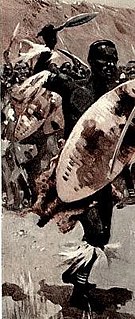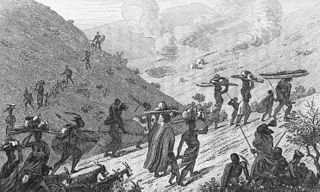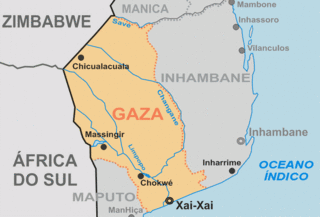
Impi is a Zulu word meaning war or combat, and by association any body of men gathered for war, for example impi ya masosha is a term denoting 'an army'. Impi were formed from multiple regiments from amakhanda. However, in English impi is often used to refer to a Zulu regiment, which is called an ibutho in Zulu, or the army itself.

Shaka kaSenzangakhona, also known as Shaka Zulu and Sigidi kaSenzangakhona, was the founder of the Zulu Kingdom from 1816 to 1828. He was one of the most influential monarchs of the Zulu, responsible for re-organizing the military into a formidable force via a series of wide-reaching and influential reforms.
Zulu people are a Nguni ethnic group in Southern Africa. The Zulu people are the largest ethnic group and nation in South Africa with an estimated 10–12 million people living mainly in the province of KwaZulu-Natal.

The Mfecane, also known by the Sesotho names Difaqane or Lifaqane is a historical period of heightened military conflict and migration associated with state formation and expansion in Southern Africa. The exact range of dates that comprise the Mfecane varries between sources. At its broadest the period lasted from the late eighteenth century to the mid-nineteenth century CE, but scholarship often focuses on an intensive period from the 1810s to the 1840s. The concept first emerged in the 1830s and centered on the actions of Shaka Zulu, who was alleged to have waged near-genocidal wars that depopulated the land and sparked a chain reaction of violence as fleeing groups sought to conquer new lands. Since the later half of the 20th century this interpretation has fallen out of favor due to a lack of compelling historical evidence. Current scholarly understanding revises the mortality figure significantly downward and attributes the root causes to complex political, economic, and environmental developments. The Mfecane is significant in that it saw the formation of novel states, institutions, and ethnic identities in Eastern Southern Africa. The Mfecane's historiography itself is also historically significant, with different versions having been employed to serve a range of political purposes since its inception as a historical concept.
Dingiswayo was a Mthethwa king, well known for his mentorship over a young Zulu general, Shaka Zulu, who rose to become the greatest of the Zulu Kings. His father was the Mthethwa king, Jobe kaKayi. It was under Dingiswayo that the Mthethwa rose to prominence, mostly employing diplomacy and assimilation of nearby chiefdoms to strengthen his power base. According to Mthethwa (1995), the Mthethwas are descended from the Nguni peoples of northern Natal and the Lubombo Mountains, whose modern identity dates back some 700 years.

The Ndwandwe–Zulu War of 1817–1819 was a war fought between the expanding Zulu Kingdom and the Ndwandwe tribe in South Africa.

The Ndwandwe are a Bantu Nguni-speaking people who populate sections of southern Africa.
Mashobane KaMangethe was a South African and Mthwakazian traditional and ancestral leader.
The Ndau an ethnic group which inhabits the areas in south-eastern Zimbabwe in the districts of Chipinge and Chimanimani in which they are natives. They are also found in parts of Bikita, in the Zambezi valley, in central Mozambique all the way to the coast and in central Malawi. The name "Ndau" is a derivation from the people's traditional salutation "Ndau wee!" in greetings and other social settings. When the Ngoni observed this, they called them the Ndau people, the name itself meaning the land, the place or the country in their language. Some suggestions are that the name is derived from the Nguni words "Amading'indawo" which means "those looking for a place" as this is what the Gaza Nguni called them and the name then evolved to Ndau. This is erroneous as the natives are described in detail to have already been occupying parts of Zimbabwe and Mozambique in 1500s by Joao dos Santos. The five largest Ndau groups are the Magova; the Mashanga; the Vatomboti, the Madanda and the Teve. Ancient Ndau People met with the Khoi/San during the first trade with the Arabs at Shiriyandenga currently known as Mapungumbye. They traded with Arabs with “Mpalu” “Njeti” and “Vukotlo’’ these are the red, white and blue coloured cloths together with golden beads. Ndau people traded traditional herbs, spiritual powers, animal skins and bones.
The Khumalo are an African clan that originated in northern KwaZulu, South Africa. The Khumalos are part of a group of Zulus and Ngunis known as the Mntungwa. Others include the Blose and Mabaso and Zikode, located between the Ndwandwe and the Mthethwa. Their most famous issue was Mzilikazi and mbolazi, an influential figure in the mfecane, and founder of the Northern Ndebele nation.
The Northern Ndebele people are a Bantu ethnic group in Southern Africa. They speak a language called isiNdebele. The Northern Ndebele were historically referred to as the Matabele by Sotho people, for a Nguni speaking person. Sotho people called all Nguni speaking people 'Matebele". That is why today there are a few tribes that live amongst the Basotho people and identify themselves as Matebele. These include from GaMashashane, Zebediela, and Mokopane near Polokwane. They identify themselves as Matebele meaning they are of Nguni origin, from Mpumalanga and in Lesotho. Mzilikazi was a contemporary of King Shaka and spoke the same language. The different between the isiNdebele language of Zimbabwe and Zulu language of South Africa is not great. The two languages are mutually intelligible to some degree, with differences in pronunciation, accents, and some loan words. There is also the use of older words in isiNdebele, with some of the words no longer being in use in isiZulu, and only older generation knows these words. The Ndebele culture and language is similar Zulu culture, as they share ancestry and common origins to Zulu people from the KwaZulu Natal (KZN) province of South Africa. The amaNdebele of Mzilikazi used the much smaller cowhide shields and short stabbing assegai of King Shaka's army. Ndebele people were also called Bathebele, which became amaNdebele.
Soshangana KaZikode, born Soshangana Nxumalo, was the Founder and the Monarch of the Gaza Empire, which at the height of its power stretched from the Limpopo river in southern Mozambique up to the Zambezi river in the north. Soshangana ruled over the Gaza state from 1825 until his death in 1858. Soshangana was also known by the name of Manukosi.

South African Bantu-speaking peoples are the majority of Black South Africans. Occasionally grouped as Bantu, the term itself is derived from the word for "people" common to many of the Bantu languages. The Oxford Dictionary of South African English describes its contemporary usage in a racial context as "obsolescent and offensive" because of its strong association with white minority rule with their Apartheid system. However, Bantu is used without pejorative connotations in other parts of Africa and is still used in South Africa as the group term for the language family.
The Zulu royal family consists of the king of the Zulus, his consorts, and all of his legitimate descendants. The legitimate descendants of all previous kings are also sometimes considered to be members.

The Gaza Empire (1824–1895) was an African empire established by general Soshangane and was located in southeastern Africa in the area of southern Mozambique and southeastern Zimbabwe. The Gaza Empire, at its height in the 1860s, covered all of Mozambique between the Zambezi and Limpopo rivers, known as Gazaland.
Nguni people refers to a group of Bantu-speaking ethnic groups that reside in South Africa, with off-shoots in neighbouring countries in Southern Africa. Swazi people live in both South Africa and Eswatini, while Northern Ndebele people live in both South Africa and Zimbabwe.

The Zulu Kingdom, sometimes referred to as the Zulu Empire or the Kingdom of Zululand, was a monarchy in Southern Africa that extended along the coast of the Indian Ocean from the Tugela River in the south to Pongola River in the north.
Mkabayi kaJama was founder and the head of the Qulusi military kraal and a regent of the Zulu. She persuaded her father, the Zulu chief Jama kaNdaba, to remarry, and acted as a regent to her ensuing half-brother, Senzangakhona.
The Qwabe Kingdom is the senior branch of the House of Malandela, the royal pre-Zulu family, descendant from Qwabe (1575) the son of Malandela or Mayandeya..








